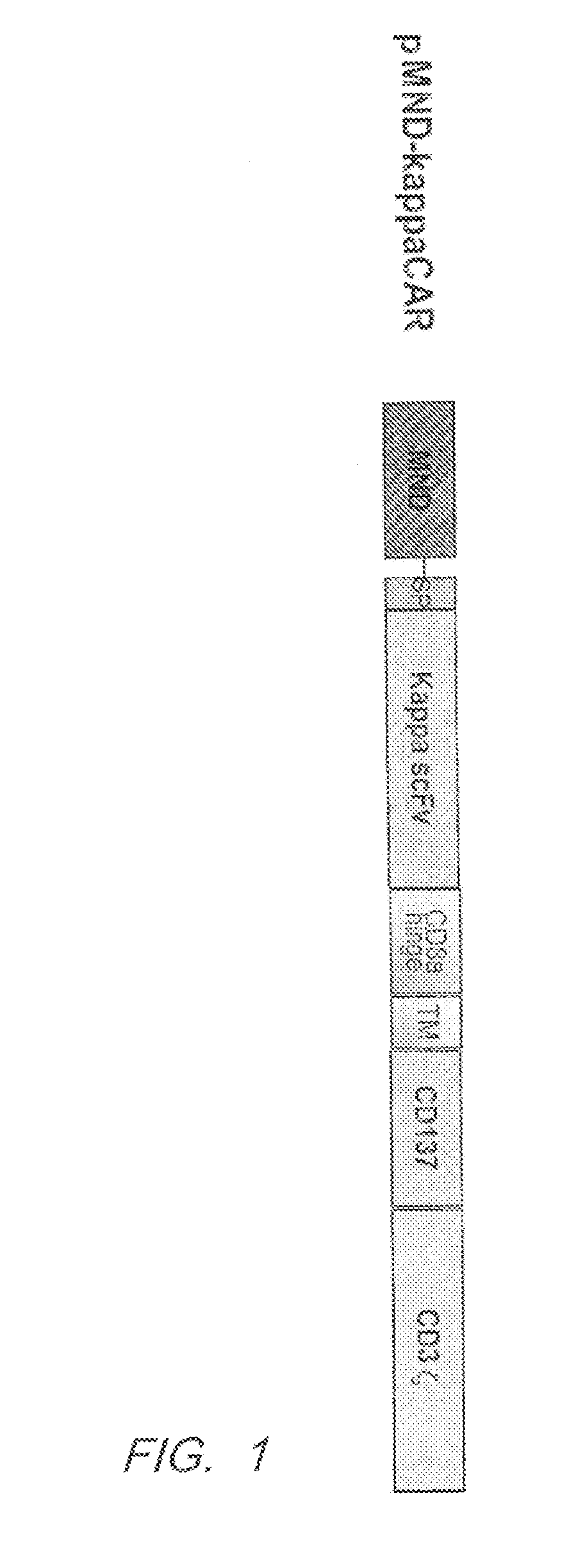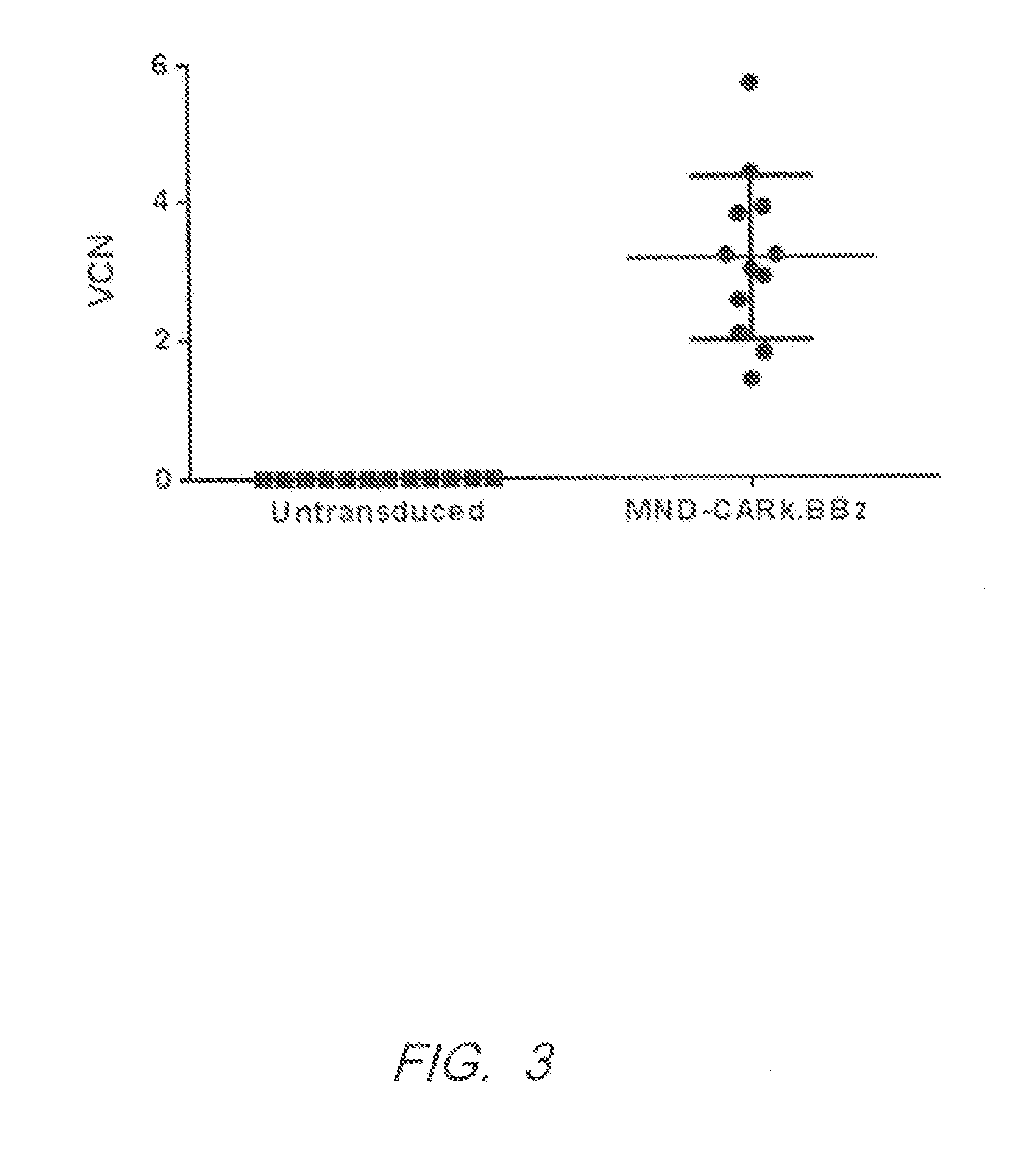Kappa/lambda chimeric antigen receptors
a chimeric antigen receptor and kappa technology, applied in the field of b cell malignancies, can solve the problems of poor pharmacokinetic profiles, limited utility of traditional methods of treating b-cell malignancies, chemotherapy and radiotherapy,
- Summary
- Abstract
- Description
- Claims
- Application Information
AI Technical Summary
Benefits of technology
Problems solved by technology
Method used
Image
Examples
example 1
Construction of CARs
[0334]1. Kappa Light Chain (KappaLC) Specific CAR (pMND-Kappa CAR)
[0335]Kappa light chain specific CARs were designed to contain an MND promoter operably linked to an anti-kappa light chain scFv, a hinge and transmembrane domain from CD8α and a CD137 co-stimulatory domains followed by the intracellular signaling domain of the CD3ζ chain. FIG. 1. The kappaLC CAR comprises a CD8α signal peptide (SP) sequence for the surface expression on immune effector cells. The polynucleotide sequence of the pMND-kappaLC CAR is set forth in SEQ ID NO: 1 and the vector map is shown in FIG. 2. Table 3 shows the Identity, Genbank Reference, Source Name and Citation for the various nucleotide segments of the pMND-kappa light chain CAR lentiviral vector.
TABLE 3GenBankNucleotidesIdentityReferenceSource NameCitation 1-185pUC19 plasmidAccessionpUC19New Englandbackbone#L09137.2Biolabsnt 1-185185-222LinkerNot applicableSyntheticNot applicable223-800CMVNot ApplicablepHCMV(1994) PNAS 91:956...
example 2
Transduction of T Cells
[0336]Lentiviral vector (LV) supernatants are produced in HEK 293T cells as described in the literature (Naldini et al., 1996, Dull et al., 1998 and Zufferey et al., 1998). Transient transfection of 5-plasmids (HPV 275 encoding HIV gag-pol, ψN 15 encoding the VSV-G envelope protein, p633 encoding the HIV rev protein, HPV601 encoding the HIV tat protein, and CAR expression vector) are used as described in PCT Publ. No. WO2012 / 170911. LV supernatants are then concentrated by either ultracentrifugation or ion-exchange column followed by tangential flow filtration (TFF), formulated into SCGM (CellGenix Inc., DE) medium, and cryopreserved at <−70° C. in single-use cryovials. Infectious titers are determined by flow cytometric analysis of transduced human osteosarcoma (HOS) cells (Kutner et al., 2009, Nature Protocols 4:495-505). For transduction of human T lymphocytes, primary human T cells are isolated from healthy volunteer donors following leukapheresis by negat...
example 3
VCN of CAR Transduced T Cells
[0337]The vector copy number for transduction of primary human T cells with pMND-kappaLC CAR lentivirus was determined. Peripheral blood mononuclear cells (PBMC) were harvested from normal donors and activated by culturing with antibodies specific for CD3 and CD28 (Miltenyi Biotec) in media containing IL-2 (CellGenix). After activation, the PBMC cultures were transduced with lentiviral vectors or left untreated. Cultures were maintained to permit outgrowth and expansion of the T cells (7-10 days). At the time of harvest, the cultures comprise T cells that have expanded approximately 2 logs.
[0338]Vector copy number (VCN) of integrated lentiviral particles was determined by q-PCR nine days after transduction. The mean VCN of 12 unique cultures from 6 donors was 3.1. FIG. 3.
PUM
| Property | Measurement | Unit |
|---|---|---|
| temperatures | aaaaa | aaaaa |
| temperatures | aaaaa | aaaaa |
| temperature | aaaaa | aaaaa |
Abstract
Description
Claims
Application Information
 Login to View More
Login to View More - R&D
- Intellectual Property
- Life Sciences
- Materials
- Tech Scout
- Unparalleled Data Quality
- Higher Quality Content
- 60% Fewer Hallucinations
Browse by: Latest US Patents, China's latest patents, Technical Efficacy Thesaurus, Application Domain, Technology Topic, Popular Technical Reports.
© 2025 PatSnap. All rights reserved.Legal|Privacy policy|Modern Slavery Act Transparency Statement|Sitemap|About US| Contact US: help@patsnap.com



